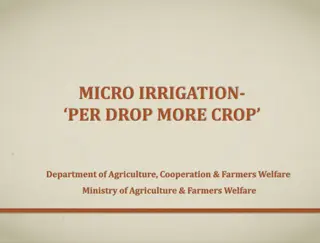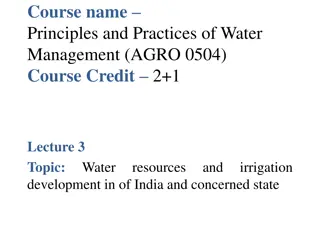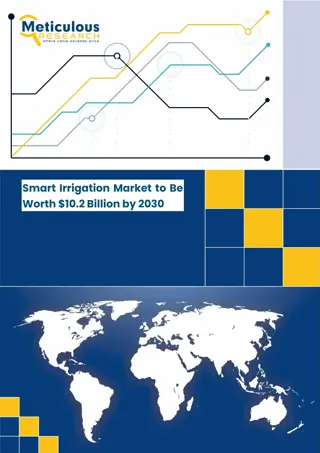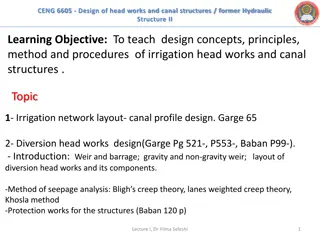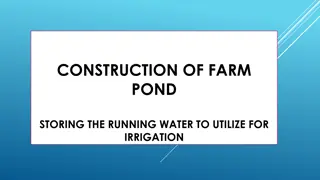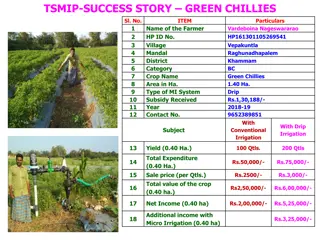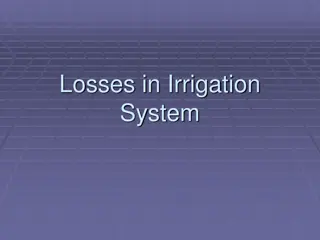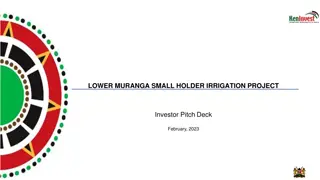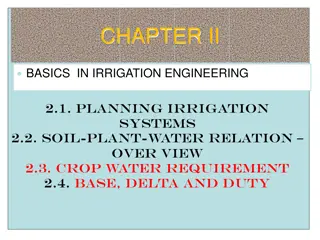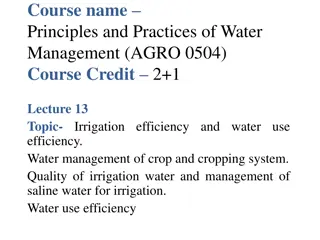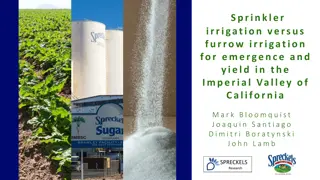Planning of Surface Irrigation Systems in Agricultural Structures: A Comprehensive Guide
Planning and implementing surface irrigation systems, such as basin irrigation and furrow irrigation, play a crucial role in optimizing water distribution for agricultural purposes. This article delves into the detailed planning considerations for basin irrigation systems, including sizing of basins based on soil type and water flow rates, evaluation methods, and advance curve monitoring. Learn how to calculate soil moisture deficiency, irrigation depth, and infiltration rates to ensure efficient water usage in agricultural fields.
Download Presentation

Please find below an Image/Link to download the presentation.
The content on the website is provided AS IS for your information and personal use only. It may not be sold, licensed, or shared on other websites without obtaining consent from the author. Download presentation by click this link. If you encounter any issues during the download, it is possible that the publisher has removed the file from their server.
E N D
Presentation Transcript
ZRAAT FAKLTES Tar msal Yap lar ve Sulama B l m TYS-624 Y zey Sulama Sistemlerinin Planlanmas Do . Dr. Kadir Ersin TEM ZEL
Tava sulama ynteminin planlanmas TYS-624 Y zey Sulama Sistemlerinin Planlanmas Hafta-12
3.2.3 Basin Irrigation System 3.2.3.1 Description: In basin irrigation, water is flooded in wider areas. It is ideal for irrigating rice. The area is normally flat. In basin irrigation, a very high stream size is introduced into the basin so that rapid movement of water is obtained. Water does not infiltrate a lot initially. At the end, a bond is put and water can pond the field. The opportunity time difference between the upward and the downward ends are reduced.
Basin Irrigation Diagram I rrigation time.
3.2.3.2 Size of Basins The size of basin is related to stream size and soil type(See Table 3.6 below). Table 3.6: Suggested basin areas for different soil types and rates of water flow Flow rate Soil Type Sand Sandy loam Clay loam l/s m3/hr .................Hectares................................ 30 108 0.02 0.06 0.20 60 216 0.04 0.12 0.40 90 324 0.06 0.18 0.60 120 432 0.08 0.24 0.80 150 540 0.10 0.30 1.00 180 648 0.12 0.36 1.20 210 756 0.14 0.42 1.40 240 864 0.16 0.48 1.60 300 1080 0.20 0.60 2.00 ........................................................................................... Note: The size of basin for clays is 10 times that of sand as the infiltration rate for clay is low leading to higher irrigation time. The size of basin also increases as the flow rate increases. The table is only a guide and practical values from an area should be relied upon. There is the need for field evaluation. Clay 0.12 0.24 0.36 0.48 0.60 0.72 0.84 0.96 1.20
3.2.3.3 Evaluation of Basin System a) Calculate the soil moisture deficiency and irrigation depth. b) Get the cumulative infiltration using either single or double ring infiltrometer. I = c Tn Infiltered Depth (mm) Time (mins)
Evaluation of a Basin System Contd. c) Get the advance curves using sticks to monitor rate of water movement. Plot a time versus distance graph (advance curve). Also plot recession curve or assume it to be straight It is ensured that water reaches the end of the basin at T/4 time and stays T time before it disappears. At any point on the advance and recession curves, get the contact or opportunity time and relate it to the depth-time graph above to know the amount of water that has infiltrated at any distance.
Depth-Distance Graphs of the Basin Irrigation System
Evaluation of Basin Irrigation Concluded. Check the deficiency and decide whether improvements are necessary or not. The T/4 time can be increased or flow rate changed. The recession curve may not be a straight line but a curve due to some low points in the basin.





